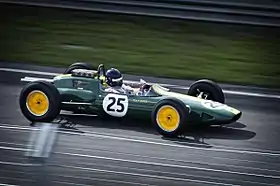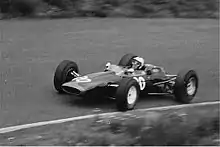Lotus 25
The Lotus 25 was a racing car designed by Colin Chapman for the 1962 Formula One season.[1] It was a revolutionary design, the first fully stressed monocoque chassis to appear in Formula One. In the hands of Jim Clark it took 14 World Championship Grand Prix wins and propelled him to his 1963 World Championship title. Its last World Championship win was at the 1965 French Grand Prix.
 | |||||||||||
| Category | Formula One | ||||||||||
|---|---|---|---|---|---|---|---|---|---|---|---|
| Constructor | Team Lotus | ||||||||||
| Designer(s) | Colin Chapman | ||||||||||
| Predecessor | Lotus 21 / Lotus 24 | ||||||||||
| Successor | Lotus 33 | ||||||||||
| Technical specifications | |||||||||||
| Chassis | Aluminium monocoque | ||||||||||
| Suspension (front) | Double wishbone, with inboard coilover spring/damper units. | ||||||||||
| Suspension (rear) | Lower wishbone, top link and radius rod suspension, with outboard coilover spring/damper units. | ||||||||||
| Engine | Coventry Climax FWMV, 1496cc, 90° V8 Naturally aspirated, mid-mounted BRM P56, 1498 cc, 90° V8 Naturally aspirated, mid-mounted | ||||||||||
| Transmission | ZF 5DS10 5-speed manual | ||||||||||
| Tyres | Dunlop | ||||||||||
| Competition history | |||||||||||
| Notable entrants | Team Lotus Reg Parnell Racing Brabham Racing Organisation | ||||||||||
| Notable drivers | |||||||||||
| Debut | 1962 Dutch Grand Prix | ||||||||||
| |||||||||||
| Constructors' Championships | 2 (1963, 1965) | ||||||||||
| Drivers' Championships | 2 (1963, 1965) | ||||||||||
| n.b. Unless otherwise stated, all data refer to Formula One World Championship Grands Prix only. | |||||||||||
It was the first Formula One car to use Esso fuel.
History
.jpg.webp)


An early brainchild of Chapman's fertile mind, the original sketches for the car were made on napkins while Chapman discussed his idea while dining out with Frank Costin (designer of Vanwall, Lotus Mk.8, 9, 10, 11 and Lotus 16 bodies, later of Marcos fame). The unveiling of the 25 at Zandvoort in 1962 was a shock for the competition, and particularly for teams like Brabham and UDT/Laystall who had recently purchased 24s from Lotus, with the understanding that they would be "mechanically identical" to the works cars - Chapman reserved the right to alter the bodywork of the cars.[2]
The monocoque made the car more rigid and structurally stronger than typical F1 cars of the period. The 25 was three times stiffer than the interim 24, while the chassis weighed only half as much.[3] The car also was extremely low and narrow, with a frontal area of 8.0 ft2 (0.74m2) as compared to the normal 9.5 ft2 (0.88 m2).[4] It was also envisaged to have a column gear lever, to keep the cockpit width to a minimum, although this was only experimental and discarded. To assist the low profile and low frontal area, the driver reclined sharply behind the wheel (an idea seen in the 18, and pioneered over a decade previously by Gustav Baumm at NSU[4][5]), leading to the nickname 'The Bathtub', while front coil/damper units were moved inboard (as in the 1948 Maserati).[6] The 25 was powered by the Mk.II 1496cc through to the Mk.5 1499cc versions of the Coventry Climax FWMV V8 in crossplane and flatplane formats. Later, Reg Parnell Racing in 1964 fitted BRM P56s of similar specification to their second-hand 25s.
Some privateers who had been buying Lotus chassis were disgruntled by the fact Chapman refused to provide them 25s. These teams, including Rob Walker Racing, were given Lotus 24s, while the works team had exclusive use of the 25 for Jim Clark and Trevor Taylor. When it first appeared at the Dutch Grand Prix, the futuristic 25 was inspected by John Cooper, who asked Chapman where he had put the frame tubes in the car.
Seven cars were built in total, numbered R1 to R7. Four cars - R1, R2, R3 and R5 - were written off (three of them by Trevor Taylor) in accidents between 1962 and 1966. The most successful was R4, which Clark drove to all seven of his World Championship wins in 1963. This car was later crashed by Richard Attwood then rebuilt as a Lotus 33 using a spare monocoque of that type and unofficially known as R13.[7]
Racing history
The car gave Clark his first World Championship Grand Prix victory, at Spa in 1962. He took another win in Britain and again in the USA, which put him in contention for the title, but while leading the final race in South Africa a much publicised engine seizure cost him the title to Graham Hill.
Clark gained his revenge the following year, taking his first World Championship in the 25, by winning 7 races, Belgium, France, Holland, Britain, Italy, South Africa, and Mexico. Lotus also won its first constructors' championship. Following the United States GP, a 25 was taken to the Indianapolis Motor Speedway for evaluation, where they also trialled Lucas electronic ignition for Ford.[8] The results were encouraging enough for Colin Chapman to mount his ultimately successful challenge on the Indianapolis 500.
The 25 was again used during the 1964 season, winning a further three races in Clark's hands. At the final race in Mexico, just as in 1962, the Climax engine developed an oil leak and with literally a lap to run Clark coasted to a halt in sight of world championship victory, this time conceding to John Surtees. Despite the introduction of the Lotus 33 in 1964, the 25 was still used until well into the 1965 season, Clark taking the car's final win at the 1965 French Grand Prix.
In 1964, Reg Parnell Racing began racing the 25, using the BRM P56 V8 engine, with limited success. Chris Irwin placed Reg Parnell Racing's 25/33 hybrid 7th in its final World Championship race at the 1967 Dutch Grand Prix, scene of the model's debut five years earlier.[9]
World Championship results
(key) (results in bold indicate pole position; results in italics indicate fastest lap)
- 1 Points were awarded on a 9-6-4-3-2-1 basis to the first six finishers at each round, but only the best placed car for each make was eligible to score points. In 1962 and 1966 only the best five results from the season were retained, and only the best six results for 1963, 1964 and 1965. In 1967 the best five results from the first six rounds and the best four results from the last five rounds were retained.
- 2 Jack Brabham raced the spare works Lotus after engine failure forced him to retire his own car.
- 3 Plans for Arundell to race the spare car were abandoned.
- 4 Clark swapped cars with Spence's Lotus 33 during the race following mechanical problems.
- 5 Revson tried out Hailwood's car in practice while the latter was away qualifying for the TT.
- 6 Total points scored by all Lotus-Climax cars, including 45 points scored by drivers of Lotus 33 variants.
- 7 Total points scored by all Lotus-Climax cars, including 8 points scored by drivers of Lotus 33 variants.
References
Notes
- Automobile Year, No. 10, 1962-1963, Pages 198-199.
- Blunsden, John (July 1962). "Lotus "Ramlösa" - Segervagnen i Spa" [Lotus' Frameless: the Victory Machine at Spa]. Illustrerad Motor Sport (in Swedish). No. 7–8. Lerum, Sweden. pp. 6–7.
- Setright, L.J.K. "Lotus: The Golden Mean", in Northey, Tom, ed. The World of Automobiles (London: Orbis, 1974), Volume 11, p.1230.
- Setright, p.1230.
- Wikipedia, Lotus 18.
- "Chapman was not concerned to be original, merely to be thorough." Setright, p.1230.
- Nye, Doug (August 2013). "A whole bunch of trouble". Motor Sport magazine archive. p. 74. Retrieved 2 August 2016.
- Super Street Cars, 9/81, p.34.
- "Dutch Grand Prix - Team Lotus return". Motor Sport magazine archive. July 1967. p. 28. Retrieved 19 December 2016.
- "Lotus 25 car-by-car histories". OldRacingCars. Retrieved 23 January 2019.
Bibliography
- Bamsey, Ian (1990). Lotus 25 Climax FWMV: A Technical Appraisal. Foulis motoring book series. Sparkford, Somerset, England; Newbury Park, CA, USA: Haynes Publishing. ISBN 0854298029.